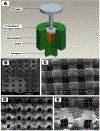Bone tissue engineering techniques, advances and scaffolds for treatment of bone defects
- PMID: 33718692
- PMCID: PMC7948130
- DOI: 10.1016/j.cobme.2020.100248
Bone tissue engineering techniques, advances and scaffolds for treatment of bone defects
Abstract
Bone tissue engineering (BTE) aims to develop strategies to regenerate damaged or diseased bone using a combination of cells, growth factors, and biomaterials. This article highlights recent advances in BTE, with particular emphasis on the role of the biomaterials as scaffolding material to heal bone defects. Studies encompass the utilization of bioceramics, composites, and myriad hydrogels that have been fashioned by injection molding, electrospinning, and 3D bioprinting over recent years, with the aim to provide an insight into the progress of BTE along with a commentary on their scope and possibilities to aid future research. The biocompatibility and structural efficacy of some of these biomaterials are also discussed.
Keywords: 3D printing; bone defect; electrospinning; injection molding; orthopedics; tissue engineering.
Conflict of interest statement
Conflict of Interest Statement William Weiss acknowledges he has no financial conflicts of interest, but serves as an editor for Canadian Orthopedic Association Bulletin, is on the editorial board for Arthroscopy: Journal of Arthroscopic and Related Surgery; Bone & Joint 360, and is on the social media board for Arthroscopy Association of North America (AANA). All other authors acknowledge no conflict of interest.
Figures




Similar articles
-
Advances in 3D printing technology for preparing bone tissue engineering scaffolds from biodegradable materials.Front Bioeng Biotechnol. 2024 Nov 14;12:1483547. doi: 10.3389/fbioe.2024.1483547. eCollection 2024. Front Bioeng Biotechnol. 2024. PMID: 39610936 Free PMC article.
-
Biomaterials in bone and mineralized tissue engineering using 3D printing and bioprinting technologies.Biomed Phys Eng Express. 2021 Oct 7;7(6). doi: 10.1088/2057-1976/ac21ab. Biomed Phys Eng Express. 2021. PMID: 34438382 Review.
-
Recent advances on 3D-printed PCL-based composite scaffolds for bone tissue engineering.Front Bioeng Biotechnol. 2023 Jun 19;11:1168504. doi: 10.3389/fbioe.2023.1168504. eCollection 2023. Front Bioeng Biotechnol. 2023. PMID: 37469447 Free PMC article. Review.
-
3D Bioprinted Scaffolds for Bone Tissue Engineering: State-Of-The-Art and Emerging Technologies.Front Bioeng Biotechnol. 2022 Apr 11;10:824156. doi: 10.3389/fbioe.2022.824156. eCollection 2022. Front Bioeng Biotechnol. 2022. PMID: 35480972 Free PMC article. Review.
-
Application of photocrosslinkable hydrogels based on photolithography 3D bioprinting technology in bone tissue engineering.Regen Biomater. 2023 Apr 24;10:rbad037. doi: 10.1093/rb/rbad037. eCollection 2023. Regen Biomater. 2023. PMID: 37250979 Free PMC article. Review.
Cited by
-
Polycaprolactone/Gelatin/Hydroxyapatite Electrospun Nanomembrane Materials Incorporated with Different Proportions of Attapulgite Synergistically Promote Bone Formation.Int J Nanomedicine. 2022 Sep 8;17:4087-4103. doi: 10.2147/IJN.S372247. eCollection 2022. Int J Nanomedicine. 2022. PMID: 36105619 Free PMC article.
-
Development of Poly(methyl methacrylate)/nano-hydroxyapatite (PMMA/nHA) Nanofibers for Tissue Engineering Regeneration Using an Electrospinning Technique.Polymers (Basel). 2024 Feb 16;16(4):531. doi: 10.3390/polym16040531. Polymers (Basel). 2024. PMID: 38399909 Free PMC article.
-
Hydroxyapatite-filled osteoinductive and piezoelectric nanofibers for bone tissue engineering.Sci Technol Adv Mater. 2023 Aug 24;24(1):2242242. doi: 10.1080/14686996.2023.2242242. eCollection 2023. Sci Technol Adv Mater. 2023. PMID: 37638280 Free PMC article.
-
3D Stem Cell Spheroids with 2D Hetero-Nanostructures for In Vivo Osteogenic and Immunologic Modulated Bone Repair.Adv Healthc Mater. 2024 May;13(12):e2303772. doi: 10.1002/adhm.202303772. Epub 2024 Feb 11. Adv Healthc Mater. 2024. PMID: 38271276 Free PMC article.
-
In Vitro Evaluation of Pore Size Graded Bone Scaffolds with Different Material Composition.3D Print Addit Manuf. 2024 Apr 1;11(2):e718-e730. doi: 10.1089/3dp.2022.0138. Epub 2024 Apr 16. 3D Print Addit Manuf. 2024. PMID: 38689909 Free PMC article.
References
-
- Kargozar Saeid, Milan Peiman Brouki, Baino Francesco, et al., Nanoengineered biomaterials for bone/dental regeneration, in Nanoengineered Biomaterials for Regenerative Medicine. 2019, Elsevier. p. 13–38.
-
- SCHMITZ JOHNP and Hollinger Jeffrey O, The critical size defect as an experimental model for craniomandibulofacial nonunions. Clinical Orthopaedics and Related Research®, 1986. 205: p. 299–308. - PubMed
-
- KEY J ALBERT, The effect of a local calcium depot on osteogenesis and healing of fractures. JBJS, 1934. 16(1): p. 176–184.
-
- McBride J, Clyde M, Banks RE, et al., Healing of segmental bone defects in goat tibia. J Invest Surg, 1993. 6: p. 369.
Grants and funding
LinkOut - more resources
Full Text Sources
Other Literature Sources
